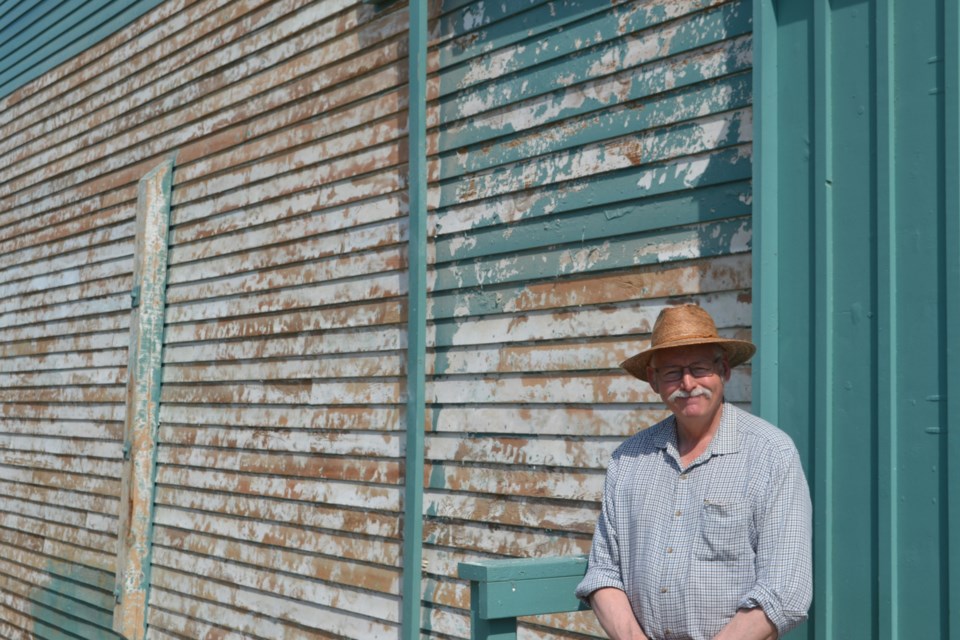Heritage Sites manager Merlin Rosser oversees the preservation of the provincially recognized elevators. That involves both interior cleaning and regular exterior work – repainting both structures every seven to 10 years to protect and maintain the integrity and beauty of what are iconic representations of Prairie life and a nod to the golden age of Canada's grain trade.
"These buildings will last another 100 years, as long as you do the maintenance," said Rosser of the roughly century-old elevators. "The work we do on the exterior also protects the history inside."
The insides of the elevators, one cedar-sided and the other covered in silver galvanized metal, have workings made of durable Douglas Fir that are regularly vacuumed and cleaned of the grain dust that still circulates decades after wheat, oats and barley were last stored in them. To keep moisture and rot out of the vulnerable interiors, moisture-repelling exterior upkeep involves work similar to that of painting any house or building: wash, scrape, fix, prime and paint. Similar, but not exactly the same.
"The wind can get under the metal sheet and rip off the galvanized siding. Wind is an enemy of the elevators, but the biggest threat is fire," added Rosser. "If the building across the tracks were on fire, a spark blown across here could be devastating. So we use a chemical-like fire guard under the siding on the wood panels before we prime and paint."
Two to four workers spend about three or four weeks on each elevator, power washing (to get ride of dust and debris), scraping off old peeling paint, repairing or replacing boards or siding that is rotted, pulled away or need patching, and then primed and covered in two coats of durable exterior latex paint.
Rosser said before it became disallowed, oil paint provided a better, more durable finish on the elevators.
"Now we use the best quality Benjamin Moore exterior latex paint for the cedar-sided elevator – a proprietary shade of green owned by Alberta Wheat Pool – and an aluminum paint made especially for our silver galvanized metal elevator, supplied by an Edmonton company. We don't use any fancy equipment for the painting itself because a four-inch roller matches the size of the siding. Repainting the Wheat Pool logo and lettering come last, but we can work into the fall if we need to, as long as the temperature stays above 10 degrees."
Crews have already finished painting the top two-thirds of Grain Elevator 1, the cedar-sided structure, which is actually the younger of the two elevators. The 86-foot-tall elevator held 37,000 bushels of grain in its working life, with the last load of grain leaving the building in 1989. Using a 125-foot boom lift and ladder to reach the upper levels, painting beside the working CN rail line means permission is needed when working on the track side of the elevators. Rosser said though there's a two- or three-foot safety space, a spotter is also used to alert crews when trains are coming.
St. Albert's historic buildings are a 1906 Brackman-Ker Milling Company Elevator (the oldest in the province, and now also a Wheat Pool elevator) and 1929 Wheat Pool Elevator, both which were designated Provincial Historic Resources in 2007. The pair received a major overhaul in 2010 (with about 40 per cent of the structures replaced) before opening to the public for tours in 2011. The year-long restoration project included repair and stabilization of the foundations, re-shingled roofs, securing the metal cladding, replacing rotten timbers and restoring windows.
St. Albert's grain elevators are two of almost 20 now being preserved in the province. Hans Huizinga, president of the Alberta Grain Elevator Society (AGES) said restoring these structures is important to help educate younger generations about the towns the elevators helped build, and for safety on the rain lines.
"Grain elevator lands are mostly leased from railway companies, who are anxious about decaying buildings falling onto the tracks," said Huizinga. "And, as a community-owned museum, part of the philosophy is also for people to see and experience these elevators. They're an oddity, too. They acted as mileposts – a marker of a location that you could spot from miles away.
"Decades ago, these elevators gave way to concrete cylinder bins, so like the family farms and many small communities, they're disappearing. There used to be hundreds and thousands of elevators in their heyday (late 1920s) and now we're preserving just a handful. The cost of restoring these elevators can be astronomical, but it's an important part of Prairie history; worth holding onto."




